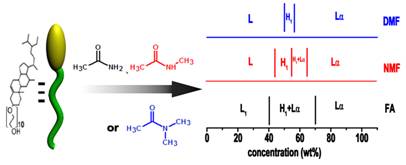| Lyotropic Liquid Crystalline Phases of a Phytosterol Ethoxylate in Amide Solvents |
| From: PublishDate:2016-01-04 Hits: |
Ethoxylated sterols, an example of environmentally benign surfactants, exhibit amphiphilic behaviors due to the hydrophobic steroid nucleus and the hydrophilic polyoxyethylene chains. As the medium of aggregates formation, changing solvent can regulate the surfactant aggregation behavior. The polarity, cohesive energy density, and ordering ability all have an influence on aggregate structure. From FA to N-methylformamide (NMF), and then N,N-dimethylformamide (DMF), the replacement of hydrogen moieties with methyl group reduces the number of donating protons successively and transforms the solvent from protic (FA) to aprotic (DMF). Utilizing the small-angle X-ray scattering (SAXS) station at Beijing Synchrotron Radiation Facility (BSRF), Chen’s group from Shandong University found that such a change would lead to pronounced changes in BPS-10 surfactant aggregation behavior. Their research results have been published on September 3rd, 2013 in Langmuir. Similar to water, FA molecules have the potential to donate or accept protons to form hydrogen-bonding networks. Thus, BPS-10 can also be assembled into H1 and Lα phases. However,after the replacement of hydrogen moieties, the threshold concentration to form the ordered assembly (LLC) increases from FA to NMF and to DMF. This behavior is due to the reduced H-bond donor capacity of DMF compared to FA, resulting in a less extensive H-bonding network and diminished solvophobic interactions of BPS-10.
In all three solvents, BPS-10 could form transparent, isotropic, and fluidal samples at low concentrations. From the SAXS profiles measured at a synchrotron source in BSRF, only one scattering peak appears in the BPS-10/FA system, indicating the presence of a micellar L1 phase. In BPS-10/NMF or DMF systems, however, no peak could be observed, possibly suggesting (for the moment) that there is no L1 phase formation in NMF or DMF. Combined with the phase behavior at higher BPS-10 concentration, a new sequence (isotropic → H1 → Lα) appears in NMF and DMF, which is different from CTAB/DMF system. This can be attributed to the strong interactions between the steroid rings, which providing enough driving forces to form H1 phases. The obtained results should be a useful addition to our understanding of steroid surfactants aggregation in nonaqueous solvents. Reference: Xiu Yue,1 Xiao Chen,1* Qintang Li,1 and Zhihong Li,2 Lyotropic Liquid Crystalline Phases Formed by Phyosterol Ethoxylates in Organic Solvent. Langmuir 29(2013), 11013-11021. 1 Key Laboratory of Colloid and Interface Chemistry, Shandong University Ministry of Education, Jinan, 250100, China 2 Institute of High Energy Physics, Chinese Academy of Sciences, Beijing, 100039, China |
|
|
| Chinese
- Beamline 1W1 of BSRF started to runoperate in the couplingparasitic mode of BEPCII
- Synthesis of High Performance Polymer Materials for Field Effect-Transistors
- Surfactant molecular aggregates in green solvents
- GIXRD has played an important role in the characterization of organic thin-film transistors
Copyright © 2011 - 2012 Beijing Synchrotron Radiation Facility


